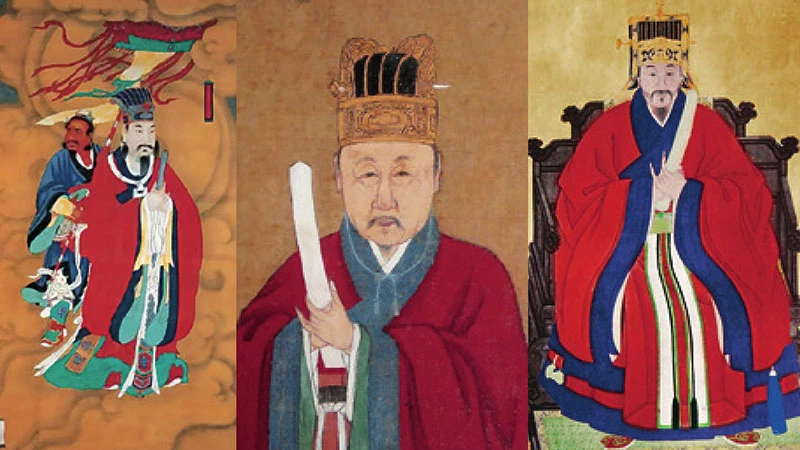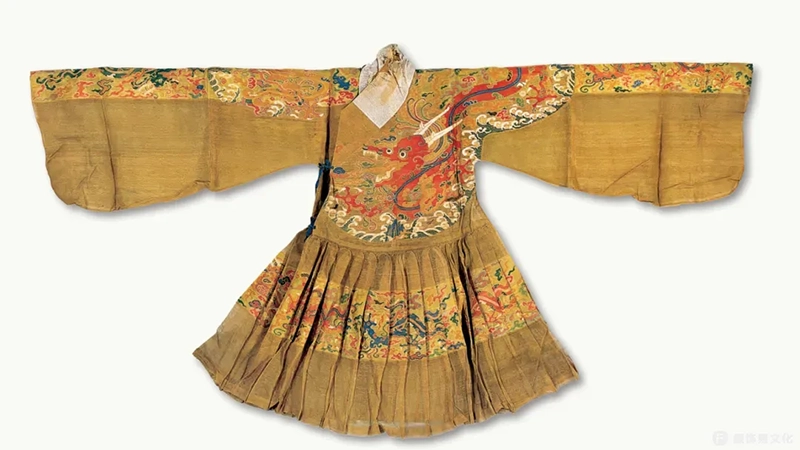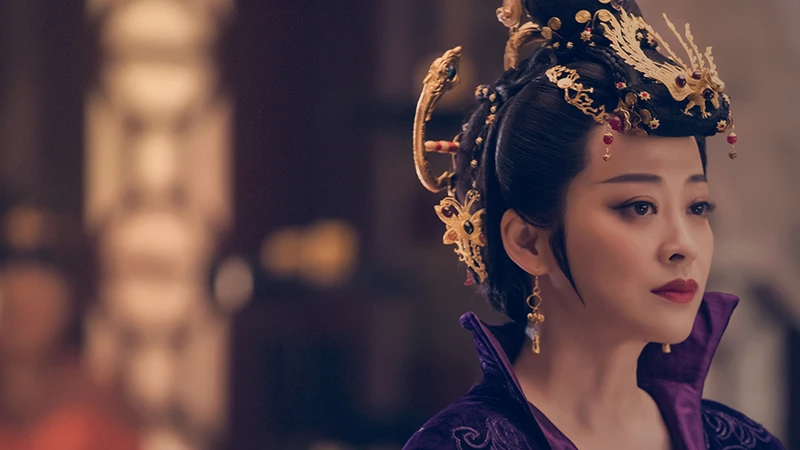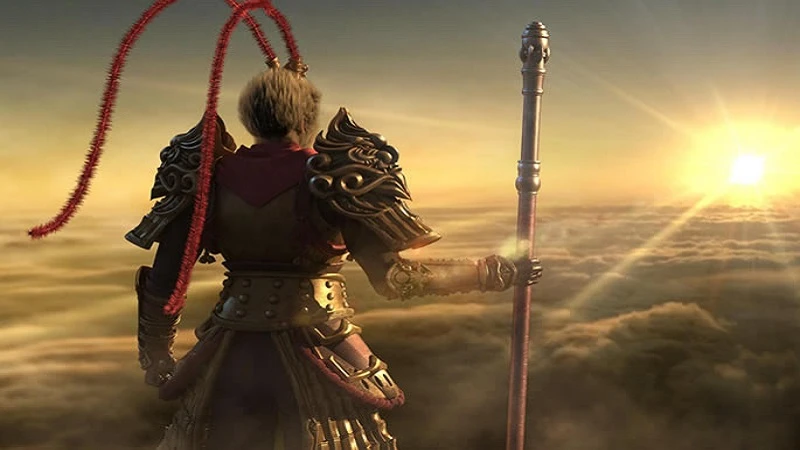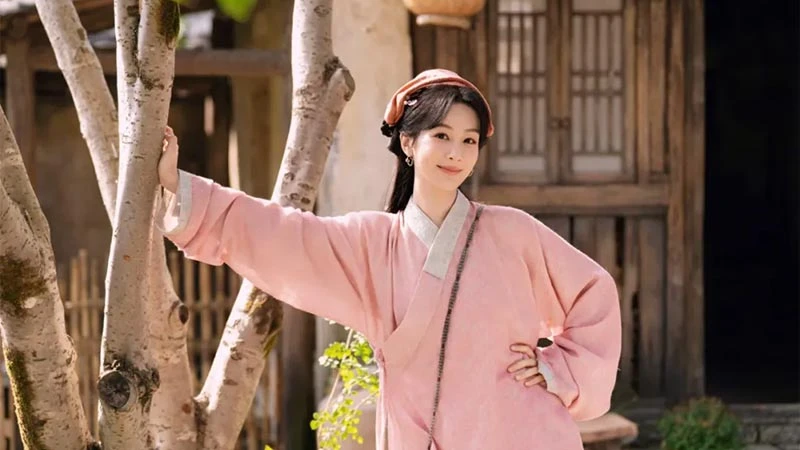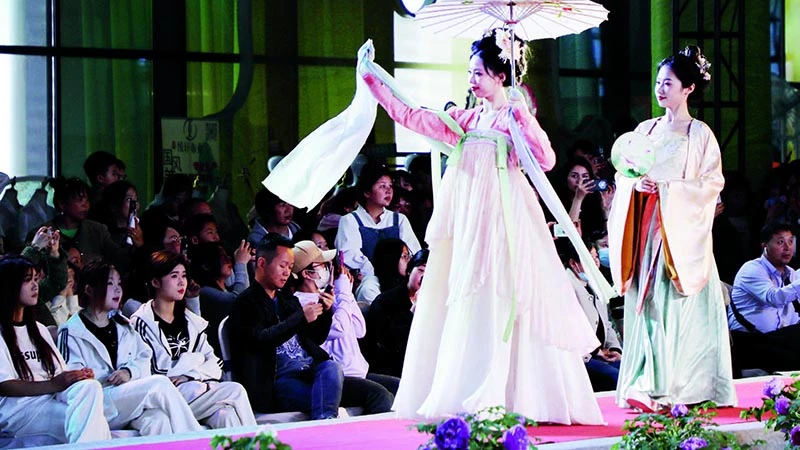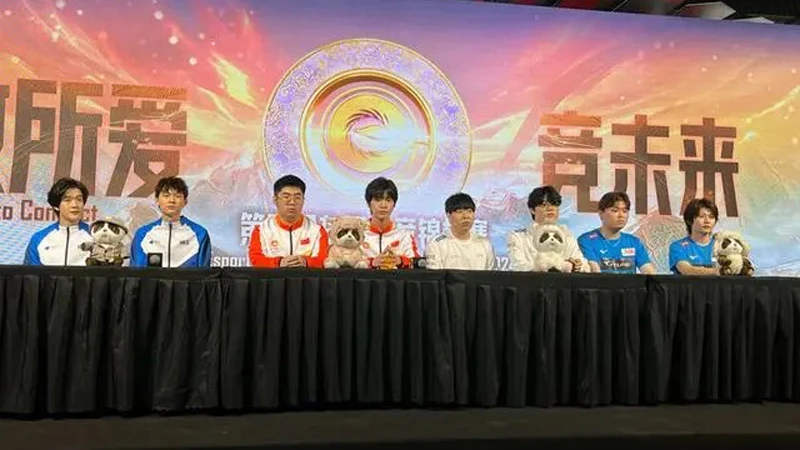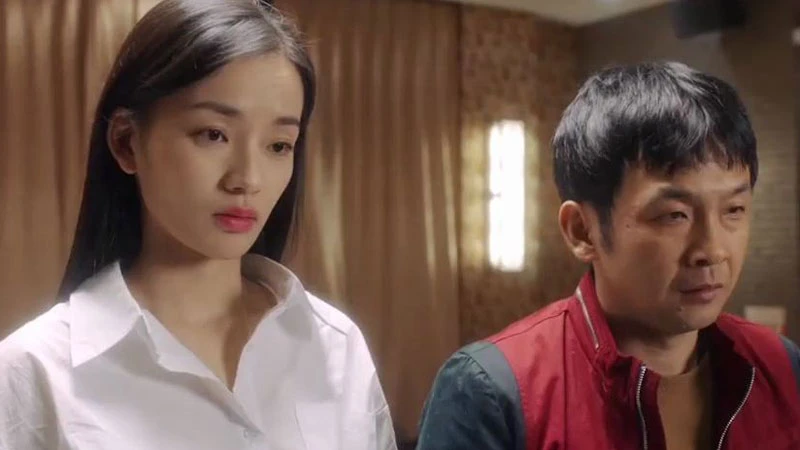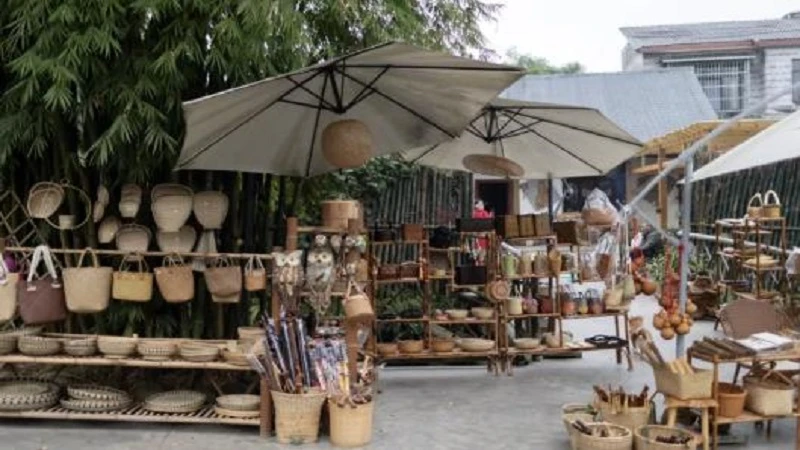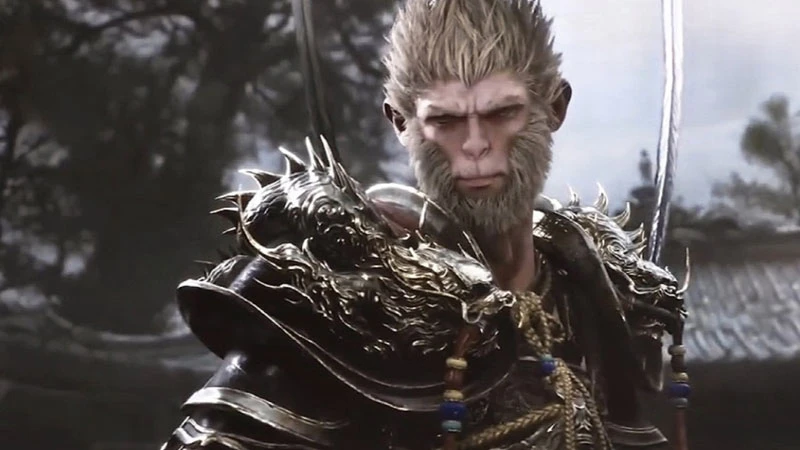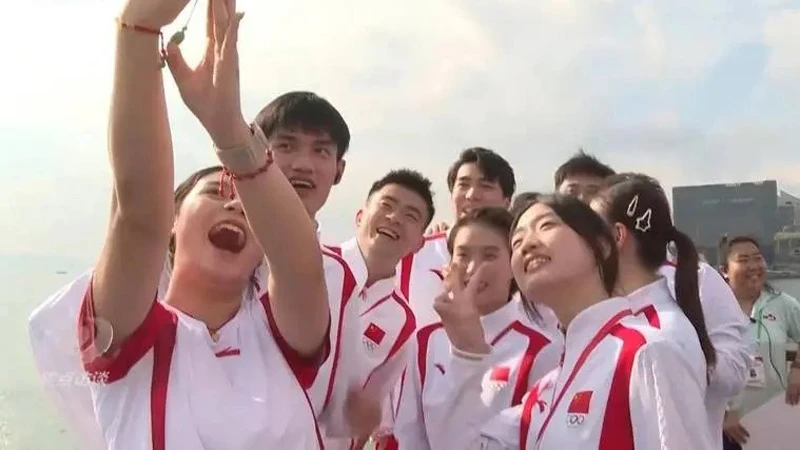Article
搜索结果:
-
Noble Lady - Chen Duling's Ming Dynasty Hanfu
Recently, the filming of "Noble Lady" starring Chen Duling (陈都灵) wrapped up, and some promotional and on - set photos of Chen Duling were released online. Some netizens said that the costumes looked a bit cheap and made the characters look old. However, another group of netizens thought that they finally saw authentic Ming - style Hanfu in a costume drama. The costumes in "Noble Lady" mainly follow the traditional Ming - Dynasty style of Hanfu. They are mainly high - collared, cross - collared long jackets, with cloaks worn over them on formal occasions, and horse - face skirts as the lower skirts. The Ming - style costumes in this drama also include high - collared, vertical - collared and cross - collared jacket - skirt sets, as well as traditional cross - collared jacket - skirt sets. Through different color combinations and patterns, the lively and playful sides of the characters can be highlighted. The overall style of the costumes in this drama is quite grand, covering printing, gold - weaving, embroidery, and hidden - pattern techniques. As the characters' identities change in the plot, the costumes gradually show the elegance of Ming - Dynasty noble ladies. Among… -
The Costume Conundrum of Ming Dynasty in 1566
As a history enthusiast and frequent viewer of period dramas, I’ve noticed a troubling trend: even well-received shows often stumble when it comes to historical accuracy in costumes. Ming Dynasty in 1566 (大明王朝1566), a political drama lauded for its intricate plot and acting, is no exception. Despite its sky-high ratings, the series fails to accurately portray Ming-era official attire—a surprising misstep given the wealth of surviving records and artifacts from the period. Historical Accuracy vs. Creative Liberties The drama revolves around court politics, featuring emperors, ministers, and bureaucrats. Ming official clothing, meticulously documented in texts like the History of Ming, leaves little room for ambiguity. Yet the show’s costume design strays far from reality. Take the officials’ headwear, for example. The odd, box-like crowns worn by characters resemble a simplified version of the Longjin (笼巾), a ceremonial headpiece reserved for nobility—not regular officials. According to the History of Ming, the Longjin was part of formal court attire (chaofu, 朝服) worn during grand ceremonies. It included intricate accessories like jade or gold cicadas, pheasant feathers, and layered silk bands. Yet in the show, the design feels cheap and anachronistic—closer to a generic “ancient official” costume bought in bulk for low-budget productions.… -
The Unexpected Modern Appeal of Ming Dynasty Fashion
If you spotted a character in a historical drama twirling in a pink, pleated dress and thought, Wow, that looks surprisingly modern, you're not alone. The outfit in question, featured in The Glory (雁回时), closely resembles a contemporary flared dress, but it actually belongs to a category of Ming Dynasty garments known as tieli (贴里). This style, along with the similar yesa (曳撒), reflects a fascinating blend of influences, practicality, and visual appeal—so much so that modern designers could easily take inspiration from it. Tieli vs. Yesa: Not Just for Women At first glance, tieli and yesa might look like elegant, structured dresses, but in the Ming Dynasty, they were primarily worn by men. Both originated under the influence of Yuan-Mongol styles but were later adapted into Han Chinese fashion. The key difference? Yesa features a smooth front panel known as a Mamian (马面), while tieli is characterized by full pleats from top to bottom. These structured garments were designed for mobility, making them popular choices for officials, scholars, and even military figures. While women occasionally wore these garments, it was often as part of cross-dressing trends in dramas or plays, where they took on male roles. Today, it’s not… -
Ming Dynasty Jewelry in "Nirvana in Fire 2"
As someone deeply passionate about historical clothing and accessories, people often ask me: "Does your knowledge of ancient fashion ruin your enjoyment of period dramas?" The answer is—quite the opposite! In fact, it adds another layer of enjoyment, turning each viewing into a treasure hunt for accurate details (or amusing anachronisms). Take "Nirvana in Fire 2" (琅琊榜之风起长林), for example. The series boasts stunning visuals, but as I watched, I couldn't help but notice a curious detail—the jewelry worn by characters like Empress Xun (荀皇后) and the Grand Lady of Laiyang (莱阳太夫人) bore striking similarities to Ming Dynasty designs. However, their application in the drama was... unconventional, to say the least. It appears that the production team sourced historically inspired pieces but missed the mark on how they were actually worn. Filigree Gold Phoenix Hairpins One of the most eye-catching pieces worn by Empress Xun is a set of three gold phoenix hairpins (累丝嵌宝石金凤簪). These exquisite accessories have a real-life counterpart: they are modeled after jewelry unearthed from Ming Dynasty imperial tombs in the western suburbs of Beijing. These tombs, unfortunately looted and excavated long ago, left behind only fragments of their once-lavish burial artifacts, yet what remains showcases remarkable craftsmanship.… -
Why Wukong Defied Becoming a Divine Mount
In the celestial hierarchy of Journey to the West (西游记), divine mounts (神骑) occupy a paradoxical role: they are both exalted and enslaved. Lions, elephants, and golden-haired beasts—once fearsome demons—are collared, neutered, and pressed into service by bodhisattvas and sages. Their domestication symbolizes Heaven's power to redeem chaos into order. Yet one figure stands apart, unbroken and unbridled: Wukong, the Monkey King. The Anatomy of a Divine Mount Heaven's stables are not filled by chance. To qualify as a mount, a creature must meet strict criteria—criteria Wukong shattered with every swing of his staff. The Biology of Submission Divine mounts are almost exclusively quadrupeds: lions, elephants, oxen, or horses. Their four-legged stance signifies stability, a biological pragmatism for carrying gods across realms. Wukong, however, is a bipedal primate—a mimic of humans who stands upright, wields tools, and laughs at gravity. His very anatomy rebels against the concept of being "ridden." In Chinese symbolism, monkeys represent the restless "heart-mind" (xinyuan), a metaphor for desires that resist control. To mount him would be to tame the untamable, a paradox even the Jade Emperor's bureaucracy couldn't resolve. The Politics of Punishment Divine mounts are not born—they are made. Take the Nine-Headed Lion, a… -
Empress's Crown: The Iconic Ming Dynasty Treasure
If you ever find yourself at the National Museum of China and notice a long queue forming, chances are visitors are eagerly waiting to catch a glimpse of one of the most exquisite artifacts of the Ming Dynasty—the Nine-Dragon and Nine-Phoenix Crown. This imperial masterpiece, once adorning the head of Empress Dowager Xiaoduan, has captured the fascination of history enthusiasts and cultural aficionados alike. Recently, the museums exclusive line of merchandise, inspired by this legendary crown, has set the internet abuzz. Among these, a meticulously crafted refrigerator magnet has gained viral status, merging traditional opulence with modern collectibles. Fortunately for admirers, the museum has now opened online reservations for the coveted item, sparing visitors the need for an early morning queue. The Nine-Dragon and Nine-Phoenix Crown was unearthed in 1957 from the underground chambers of the Ming Dingling Mausoleum in Beijing, resting alongside other stunning imperial headpieces. The tomb housed four intricately designed crowns: the Three-Dragon and Two-Phoenix Crown, the Nine-Dragon and Nine-Phoenix Crown, the Twelve-Dragon and Nine-Phoenix Crown, and the Six-Dragon and Three-Phoenix Crown. Among these, the Nine-Dragon and Nine-Phoenix Crown, once worn by Empress Dowager Xiaoduan, stands out as a symbol of regal sophistication. Its significance is so… -
Unveiling the Ming Dynasty: Under the Moonlight
Set against the backdrop of the Ming Dynasty, Under the Moonlight (锦囊妙录) is poised to be the next big hit in the realm of historical mystery dramas. Slated for a prime-time premiere on CCTV-8 starting January 14, with exclusive streaming on Youku, this series promises to deliver a captivating mix of suspense, romance, and cultural richness. With its intricate storytelling, visually stunning aesthetics, and deep dive into Ming Dynasty folklore, the show is set to captivate audiences across North America, Southeast Asia, and the broader English-speaking world. A Tale of Intrigue and Romance At the heart of Under the Moonlight lies the compelling partnership between Luo Shu (罗疏), a determined woman fighting against her tragic fate, and Qi Menglin (齐梦麟), a free-spirited young man eager to carve his own path in the world. Together, they form an unlikely detective duo, navigating a series of baffling cases that test their wits and resolve. Each case they tackle reveals not only the complexities of human nature but also the societal injustices of the era, particularly those faced by women. As they unravel one mystery after another, their bond deepens, blending professional camaraderie with budding romance. However, their journey is far from straightforward.… -
Yang Zi Stuns in Ming Dynasty-Inspired Hanfu
Chinese actress Yang Zi (杨紫), known for her versatile roles in television dramas, has once again captured the public’s attention—this time, not for her acting, but for her impeccable fashion sense. Recently, the star shared photos of herself dressed in Hanfu, traditional Chinese clothing, to celebrate the Lantern Festival. The images, which quickly went viral, showcased Yang Zi in two stunning Ming Dynasty-inspired outfits, sparking discussions about the modern revival of Hanfu and its place in everyday fashion. A Nod to Ming Dynasty Elegance Yang Zi’s Hanfu choices are rooted in the Ming Dynasty (1368–1644), a period known for its rich cultural heritage and distinctive fashion. The two outfits she wore are variations of aoqun (袄裙), a traditional style consisting of a top (ao) and a skirt (qun). The first ensemble features a soft pink ao with a crossed collar, paired with a gray pleated skirt. The second look is a refreshing green ao with a front-opening design, layered over a subtle red undergarment, creating a harmonious yet striking color contrast. What makes Yang Zi’s outfits stand out is their accessibility. Unlike the elaborate Hanfu often seen in historical dramas, her choices are tailored for modern wear. The muted tones—pink,… -
Ming Xiu's Transformation: Bingke Bai's Breakout Role
The increasing popularity of historical fantasy dramas has brought new and exciting performances to the forefront. Sword and Fairy 6 6 (祈今朝), a recent hit in the winter TV season, has captivated audiences not only with its gripping storyline but also through the vivid portrayal of its ensemble cast. Among the many colorful characters, Ming Xiu (明绣), played by Bingke Bai (白冰可), has emerged as a standout. With a role deeply rooted in both personal growth and the overarching themes of sacrifice and destiny, Ming Xiu's evolution has become one of the most poignant aspects of the series. The Emotional Journey of Ming Xiu Ming Xiu's backstory is one filled with both tragedy and transformation. As a child, she witnessed her mother’s death at the hands of demons. This traumatic experience led her to a deep hatred for these creatures and a desire to remain within the safety of her master, Gu Hanjiang (顾寒江). Gu, who adopts her and raises her as a disciple, becomes her sole anchor in a world full of chaos. Initially, Ming Xiu is cold and distant, keeping others at arm’s length, trusting only her master. Her sharp tongue and prickly attitude, often seen in her… -
Dong Mingzhu's Hanfu Experience in Cao County
It was an ordinary day in the historic streets of Luoyang when Dong Mingzhu (董明珠), a celebrated Chinese business leader, donned her first Hanfu—a pale blue Ming-style ensemble that caught the eyes of onlookers. Just eight days later, she returned, this time wearing a regal Tang dynasty outfit that matched her commanding presence. Accompanied by her friends, each draped in their chosen styles, Dong’s adventures became a viral moment for Hanfu lovers across China. While Dong’s choice in Hanfu showcased her unique personality, the quiet star of her story was an unassuming county in Shandong—Cao County (曹县). The Hanfu she wore, like many others seen in ancient-style photoshoots or festivals, originated from this lesser-known corner of China. The Small Town with Big Hanfu Dreams Located in southeastern Shandong, Cao County has undergone a cultural and economic metamorphosis. On the surface, it remains humble—far from the bustling touristy image one might expect. But venture fifteen kilometers to Daji Township, and you step into a thriving hub of creativity and entrepreneurship, where small shops handle everything from fabric cutting to digital printing and logistics. Once famous for its mass production of performance costumes, Cao County has emerged as a center of affordable… -
Yao Ming Steps Down: The End of an Era
In a significant move that marks the end of an era for Chinese basketball, Yao Ming (姚明) has announced his resignation as President of the Chinese Basketball Association (CBA). After serving for seven years in this influential role, Yao, whose name has become synonymous with basketball in China, has decided to step down to focus on personal plans and the long-term development of the sport in the country. During his tenure, which began in 2017, Yao played a pivotal role in shaping the modern landscape of Chinese basketball. His leadership was instrumental in advancing the sport at grassroots and professional levels, introducing key reforms, and driving a vision of basketball's growth in China. However, despite the many accomplishments, his time as CBA president was also marked by challenges, particularly on the international stage. Yao Ming's Legacy: Transformation and Setbacks When Yao Ming first took the reins of the Chinese Basketball Association in 2017, he inherited a sport that needed structural and systemic reform. As the former NBA All-Star and global basketball icon, Yao brought star power and a deep understanding of the game to the role. Under his leadership, the CBA witnessed several significant developments. The most notable was the… -
A Fusion of Gaming and Tourism in Chengdu
In recent years, esports has grown from a niche interest to a mainstream phenomenon, particularly in East Asia. The esports ecosystem has grown exponentially, from thrilling international competitions to local gaming communities. This shift has brought about new cultural opportunities, and the integration of esports with tourism and local culture has become a driving force in major cities across Asia. This evolution is being taken to new heights in Chengdu, a city known for its rich heritage and vibrant gaming scene. From November 1 to November 3, Chengdu hosted the Fourth East Asia Esports Championship, marking the first event in a physical venue in China. This year's theme, "Travel with the Tournament," highlighted the competitive gaming spirit and embraced the cultural and tourism opportunities esports events offer local cities. The event was a dazzling showcase of how gaming, culture, and tourism can synergize to attract global attention. A Celebration of Regional Unity and Competition The East Asia Esports Championship is more than just a tournament; it is a platform for regional collaboration between China, Japan, South Korea, and Hong Kong. As esports has become a significant part of youth culture in these countries, the championship acts as a bridge for… -
Desert Harvest: Crab Farming on the Sands of Taklamakan
The Taklamakan Desert, known for its unforgiving landscape, is the last place most would expect to find a thriving aquaculture industry. Yet, against all odds, the desert sands of Hotan County in Xinjiang, China, are now home to a booming crab farming operation. With technical expertise and innovative agricultural practices, local farmers and researchers have managed to transform salt-laden sands into a source of prosperity and opportunity. The initiative, driven by the unique salt-rich soil and fresh river water, has introduced large-scale crab farming to a region where the environment otherwise resists typical agricultural efforts. This success story represents a blend of science, local determination, and nature’s unlikely gifts that together create a remarkable example of sustainable farming in a challenging ecosystem. The Unique Qualities of the Taklamakan Soil The land along the edges of the Taklamakan Desert is characterized by a high salt content that normally impedes vegetation growth. Yet, this seemingly inhospitable feature has become an advantage for aquaculture. Technicians discovered that these salt levels are not only tolerable but beneficial for crab farming. The saline environment enhances the texture of the crab meat, giving it a firmer, more flavorful quality that appeals to consumers. With this knowledge,… -
A Tale of Sequels, Setbacks, and Streaming
In the vast ocean of China's streaming content, an unexpected ripple has caught the attention of internet users. "Fierce Dragon Crossing the Gorge 2," (猛龙过沟 2) a sequel to a virtually unknown predecessor, has quietly appeared on digital platforms, sparking curiosity and conversation despite its lack of promotional fanfare and modest performance metrics. The Surprising Resilience of a Low-Budget Sequel The journey of "Fierce Dragon Crossing the Gorge 2" is a testament to the unpredictable nature of the entertainment industry. Its predecessor, released in 2022 after a two-year delay, was by all accounts a commercial disaster. With a budget of 5 million yuan and box office returns of merely 345,000 yuan, the first installment seemed to spell doom for any potential franchise aspirations. Yet, against all odds, the sequel has managed to generate buzz, albeit not in the traditional sense of viewership numbers or critical acclaim. The film, starring Zhou Yunpeng, a disciple of the renowned comedian Zhao Benshan, has become a topic of discussion due to its very existence in the face of its predecessor's failure. The Ripple Effect of Poor Investments in China's Streaming Film Industry The saga of "Fierce Dragon Crossing the Gorge" and its sequel highlights the challenges… -
How Shanghai's Gaming Industry is Reshaping Cultural Narratives
Return of the Dragon Tide - Merges Heritage In the bustling heart of Shanghai's Xuhui District, a revolution is brewing. Not on the streets, but in the pixels and code of a highly anticipated mobile game. "Return of the Dragon Tide," (归龙潮) a labor of love four years in the making, is set to make waves in the gaming world and beyond when it launches its public beta on September 13th. With over 10 million pre-registrations, this game isn't just another entry in the crowded mobile market – it's a cultural phenomenon waiting to happen. The game's premise is as ambitious as it is unique. Players step into the shoes of a film director, navigating a cityscape that blends the traditional with the futuristic. This "Nine Dragon District" serves as a microcosm of China itself, with each area meticulously crafted to represent different regions of the country. From the spicy streets of Chongqing to the neon-lit alleys of Shanghai, the game promises a virtual tour of China's diverse cultural landscape. But "Return of the Dragon Tide" is more than just a pretty facade. It's the vanguard of a new movement in Chinese gaming – one that seeks to authentically represent and celebrate Chinese… -
The Evolution of Daoming Bamboo Art Village
Nestled amidst the serene bamboo groves and traditional white-walled, blue-tiled houses of the Sichuan countryside lies Daoming (道明) Bamboo Art Village. A mere four years ago, this village, located in Longhuang Village, Daoming Town, Chongzhou, was just one of many ordinary rural settlements in western Sichuan. Today, however, it has transformed into a vibrant cultural hub known far beyond China's borders. Not only does it showcase its rich bamboo weaving heritage, but it has also made a name for itself internationally, representing Chinese rural beauty at events like the Venice Biennale. This transformation is a perfect example of the success of Chengdu's rural revitalization initiative, reflecting a broader vision of creating beautiful, livable, and ecologically balanced spaces. The success of Daoming Bamboo Art Village demonstrates how an underdeveloped rural area can reinvent itself while preserving its cultural roots. The Struggles of a Forgotten Village Before its transformation, Longhuang Village was like many other traditional villages in China—charming but underdeveloped. It was home to a few elderly residents and women, while most of the younger generation had left in search of better opportunities in urban areas. The village's main source of income was bamboo weaving, a craft with roots tracing back… -
The Growing Potential of Alpaca Farming in China
Alpaca farming has emerged as a unique and profitable venture in China's growing agricultural landscape. With a focus on niche markets and premium products, this industry has garnered attention for its multifaceted revenue streams. In regions such as Inner Mongolia’s Xilingol League (内蒙古锡林郭勒盟), farmers like Chi Haitao (迟海涛) have transformed alpaca breeding into a thriving business, bringing significant economic benefits to local communities. The rising interest in alpacas is not just limited to their appeal as adorable animals but extends to their high-value contributions in wool, meat, and tourism markets. A Lucrative Wool Industry One of the primary revenue sources for alpaca farmers is their high-quality wool. Alpaca wool is renowned for its softness, elasticity, and natural sheen, making it a premium material in the global textile market. Unlike sheep wool, alpaca fibers are free of lanolin, which makes them hypoallergenic and more environmentally friendly. Each alpaca can produce between 3 to 5 kilograms of wool annually, and the wool’s market value can range from $50 to $268 per kilogram, depending on the quality. This high demand for alpaca wool places the industry at the forefront of sustainable and luxurious textiles. In particular, alpaca wool’s tensile strength is nearly double… -
The Art of Mini-Masterpieces: Animation's Pivotal Role in Gaming
How Animated Shorts are Elevating Video Game Narratives In the ever-evolving landscape of video game development, a new trend is emerging that blends the immersive world of gaming with the artistic finesse of animation. This fusion is perfectly exemplified in the recent release of "Black Myth: Wukong," (黑神话:悟空) a highly anticipated Chinese game that has captivated players not just with its gameplay, but with its series of animated short films that punctuate the gaming experience. These animated interludes, six in total, have become a talking point among gamers and animation enthusiasts alike. Each short film, crafted in a distinct style ranging from traditional 2D hand-drawn animation to stop-motion and ink-wash painting, serves to enrich the game's narrative while showcasing the diverse talents of China's animation industry. The culmination of this artistic endeavor is "Unfinished," the hidden ending animation that has left players both satisfied and intrigued. Created through a collaboration of renowned Chinese animation studios including Wolf Smoke Studio, Fantasy Animation, Jinghuatang, and Maidong Pictures, "Unfinished" is a testament to the power of collective creativity in the animation field. The production of "Unfinished" began in May 2023, making it the last of the six animated shorts to enter production. Despite the tight… -
Mainland Olympic Athletes' Heartwarming Visit to Hong Kong
Athletes and Citizens Unite Through Shared Joy Mainland China's Olympic athletes concluded their heartwarming three-day visit to Hong Kong on August 31 before heading to Macau. From August 29 to 31, the athletes delighted Hong Kong citizens with their vibrant energy, warmth, and relaxed charm. This visit, packed with sporting demonstrations and community interactions, not only showcased athletic prowess but also built a bridge of emotions between mainland athletes and Hong Kong residents. The Olympic delegation's schedule was filled with activities, from sports demonstrations in badminton, gymnastics, table tennis, diving, and swimming to meaningful exchanges with local athletes. Highlights of the trip included appearances at Victoria Park Swimming Pool and Queen Elizabeth Stadium, where the mainland athletes dazzled spectators and engaged in friendly competition with Hong Kong's athletes. Their sincere and joyful demeanor left a lasting impression on all who attended. The athletes' presence in Hong Kong was more than just a display of skill—it was a testament to the unifying power of sports. Their performances and interactions showed that, beyond competition, sports can foster genuine connections between people. Relaxed but Ready - Mainland Athletes Share Lighter Moments The athletes' visit to Hong Kong was not only about showcasing talent… -
How Black Myth:Wukong is Redefining Chinese Gaming
In the ever-evolving landscape of global gaming, a new contender has emerged from the East, captivating players worldwide and challenging long-held perceptions of Chinese game development. 'Black Myth: Wukong' (黑神话:悟空), an action role-playing game based on the classic Chinese novel 'Journey to the West', has not only shattered sales records but has also ignited a cultural phenomenon that extends far beyond the realm of pixels and polygons. From Legend to Pixels: The Cultural Revolution of Black Myth: Wukong When Game Science Studio unveiled 'Black Myth: Wukong', few could have predicted the seismic impact it would have on the gaming industry and Chinese culture at large. Within just three days of its release, the game sold an astonishing 10 million copies, a feat that has left industry analysts scrambling to update their projections. But the true revolution lies not in the numbers, but in the game's ability to serve as a digital ambassador for Chinese mythology and literature. Across social media platforms and gaming forums, a curious trend has emerged: Western players, enthralled by the game's rich narrative and intricate world-building, are turning to the source material that inspired it. Reddit threads are awash with discussions of 'Journey to the West', as…

